Business and Professional Ethics: Robots, Taxes, and Ethical Theories
VerifiedAdded on 2022/11/09
|8
|3453
|2
Essay
AI Summary
This essay delves into the ethical complexities surrounding the integration of robotics and artificial intelligence in business operations. It begins by examining the utilitarian and Kantian ethical perspectives on the use of robots, particularly focusing on the potential for job displacement and the moral implications of automation. The essay then introduces and applies virtue ethics to the issue, analyzing the moral character and virtues that should guide businesses in their implementation of robotics. It considers issues such as data security, privacy, and the potential for human and gender bias in AI programming. The analysis extends to the potential benefits and drawbacks of taxing businesses that heavily rely on robotic automation. The essay concludes by synthesizing these perspectives to offer a comprehensive ethical evaluation of the use of robots in business and the importance of ethical considerations when implementing these technologies.

BUSINESS AND PROFESSIONAL ETHICS
Paraphrase This Document
Need a fresh take? Get an instant paraphrase of this document with our AI Paraphraser
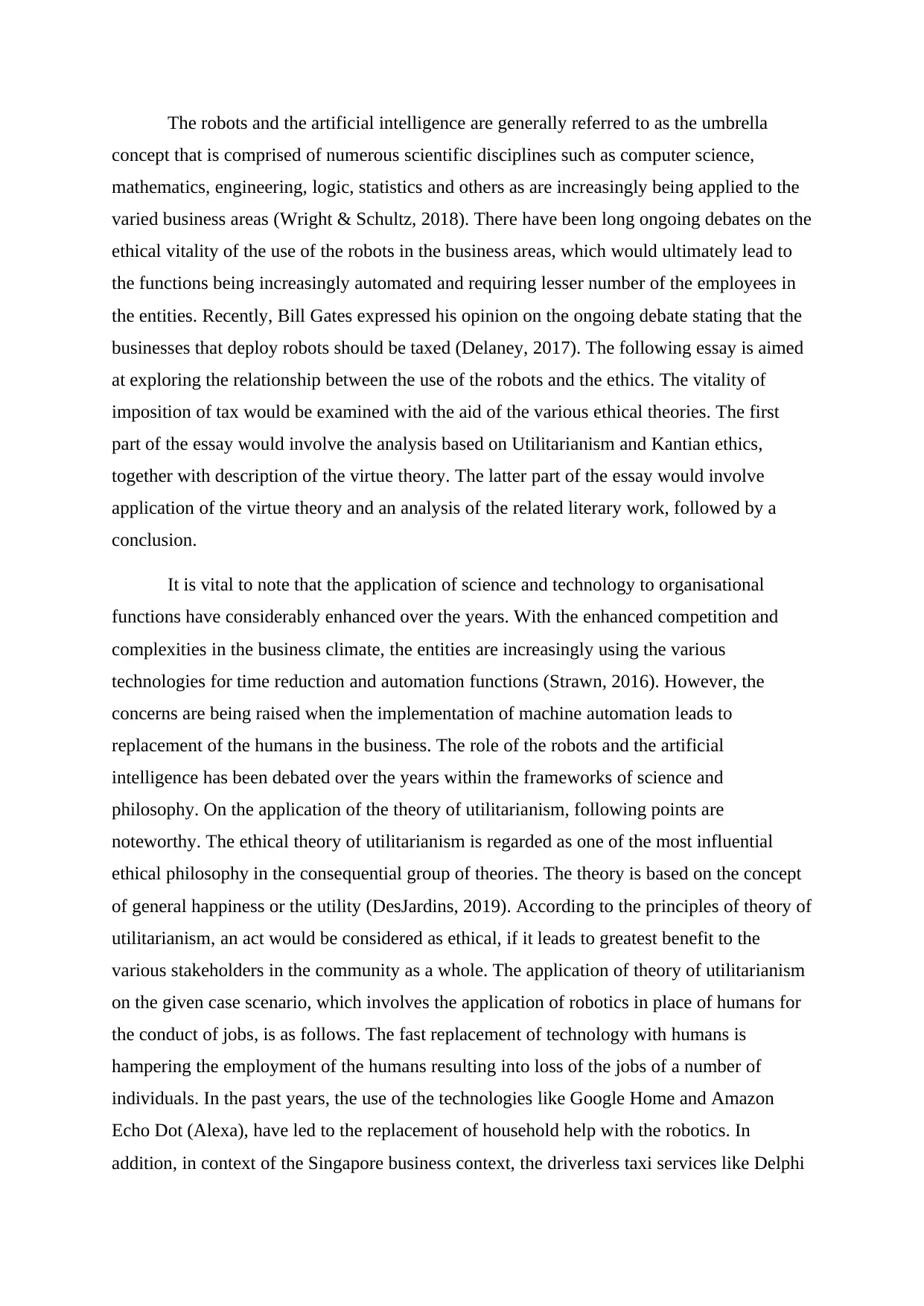
The robots and the artificial intelligence are generally referred to as the umbrella
concept that is comprised of numerous scientific disciplines such as computer science,
mathematics, engineering, logic, statistics and others as are increasingly being applied to the
varied business areas (Wright & Schultz, 2018). There have been long ongoing debates on the
ethical vitality of the use of the robots in the business areas, which would ultimately lead to
the functions being increasingly automated and requiring lesser number of the employees in
the entities. Recently, Bill Gates expressed his opinion on the ongoing debate stating that the
businesses that deploy robots should be taxed (Delaney, 2017). The following essay is aimed
at exploring the relationship between the use of the robots and the ethics. The vitality of
imposition of tax would be examined with the aid of the various ethical theories. The first
part of the essay would involve the analysis based on Utilitarianism and Kantian ethics,
together with description of the virtue theory. The latter part of the essay would involve
application of the virtue theory and an analysis of the related literary work, followed by a
conclusion.
It is vital to note that the application of science and technology to organisational
functions have considerably enhanced over the years. With the enhanced competition and
complexities in the business climate, the entities are increasingly using the various
technologies for time reduction and automation functions (Strawn, 2016). However, the
concerns are being raised when the implementation of machine automation leads to
replacement of the humans in the business. The role of the robots and the artificial
intelligence has been debated over the years within the frameworks of science and
philosophy. On the application of the theory of utilitarianism, following points are
noteworthy. The ethical theory of utilitarianism is regarded as one of the most influential
ethical philosophy in the consequential group of theories. The theory is based on the concept
of general happiness or the utility (DesJardins, 2019). According to the principles of theory of
utilitarianism, an act would be considered as ethical, if it leads to greatest benefit to the
various stakeholders in the community as a whole. The application of theory of utilitarianism
on the given case scenario, which involves the application of robotics in place of humans for
the conduct of jobs, is as follows. The fast replacement of technology with humans is
hampering the employment of the humans resulting into loss of the jobs of a number of
individuals. In the past years, the use of the technologies like Google Home and Amazon
Echo Dot (Alexa), have led to the replacement of household help with the robotics. In
addition, in context of the Singapore business context, the driverless taxi services like Delphi
concept that is comprised of numerous scientific disciplines such as computer science,
mathematics, engineering, logic, statistics and others as are increasingly being applied to the
varied business areas (Wright & Schultz, 2018). There have been long ongoing debates on the
ethical vitality of the use of the robots in the business areas, which would ultimately lead to
the functions being increasingly automated and requiring lesser number of the employees in
the entities. Recently, Bill Gates expressed his opinion on the ongoing debate stating that the
businesses that deploy robots should be taxed (Delaney, 2017). The following essay is aimed
at exploring the relationship between the use of the robots and the ethics. The vitality of
imposition of tax would be examined with the aid of the various ethical theories. The first
part of the essay would involve the analysis based on Utilitarianism and Kantian ethics,
together with description of the virtue theory. The latter part of the essay would involve
application of the virtue theory and an analysis of the related literary work, followed by a
conclusion.
It is vital to note that the application of science and technology to organisational
functions have considerably enhanced over the years. With the enhanced competition and
complexities in the business climate, the entities are increasingly using the various
technologies for time reduction and automation functions (Strawn, 2016). However, the
concerns are being raised when the implementation of machine automation leads to
replacement of the humans in the business. The role of the robots and the artificial
intelligence has been debated over the years within the frameworks of science and
philosophy. On the application of the theory of utilitarianism, following points are
noteworthy. The ethical theory of utilitarianism is regarded as one of the most influential
ethical philosophy in the consequential group of theories. The theory is based on the concept
of general happiness or the utility (DesJardins, 2019). According to the principles of theory of
utilitarianism, an act would be considered as ethical, if it leads to greatest benefit to the
various stakeholders in the community as a whole. The application of theory of utilitarianism
on the given case scenario, which involves the application of robotics in place of humans for
the conduct of jobs, is as follows. The fast replacement of technology with humans is
hampering the employment of the humans resulting into loss of the jobs of a number of
individuals. In the past years, the use of the technologies like Google Home and Amazon
Echo Dot (Alexa), have led to the replacement of household help with the robotics. In
addition, in context of the Singapore business context, the driverless taxi services like Delphi
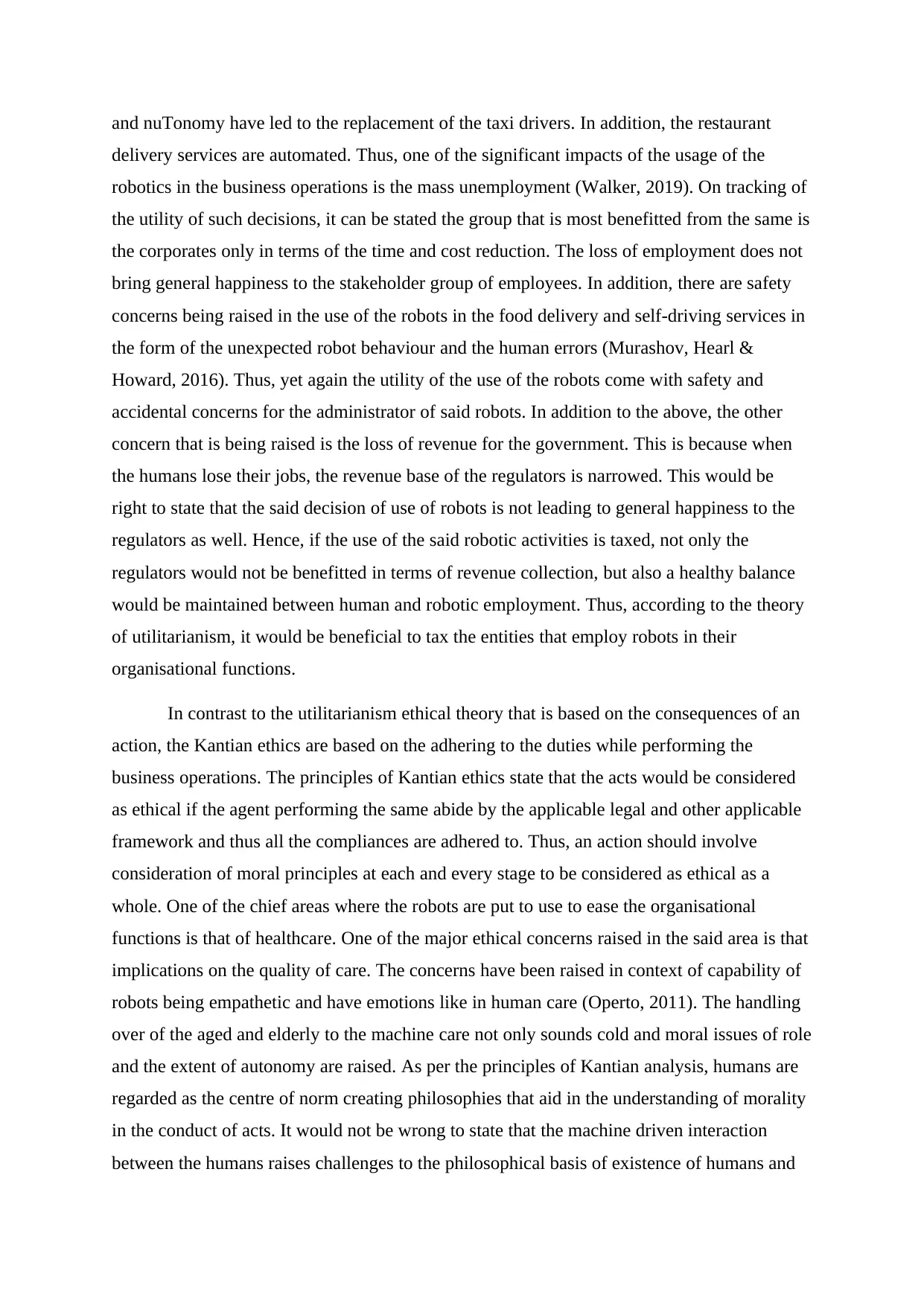
and nuTonomy have led to the replacement of the taxi drivers. In addition, the restaurant
delivery services are automated. Thus, one of the significant impacts of the usage of the
robotics in the business operations is the mass unemployment (Walker, 2019). On tracking of
the utility of such decisions, it can be stated the group that is most benefitted from the same is
the corporates only in terms of the time and cost reduction. The loss of employment does not
bring general happiness to the stakeholder group of employees. In addition, there are safety
concerns being raised in the use of the robots in the food delivery and self-driving services in
the form of the unexpected robot behaviour and the human errors (Murashov, Hearl &
Howard, 2016). Thus, yet again the utility of the use of the robots come with safety and
accidental concerns for the administrator of said robots. In addition to the above, the other
concern that is being raised is the loss of revenue for the government. This is because when
the humans lose their jobs, the revenue base of the regulators is narrowed. This would be
right to state that the said decision of use of robots is not leading to general happiness to the
regulators as well. Hence, if the use of the said robotic activities is taxed, not only the
regulators would not be benefitted in terms of revenue collection, but also a healthy balance
would be maintained between human and robotic employment. Thus, according to the theory
of utilitarianism, it would be beneficial to tax the entities that employ robots in their
organisational functions.
In contrast to the utilitarianism ethical theory that is based on the consequences of an
action, the Kantian ethics are based on the adhering to the duties while performing the
business operations. The principles of Kantian ethics state that the acts would be considered
as ethical if the agent performing the same abide by the applicable legal and other applicable
framework and thus all the compliances are adhered to. Thus, an action should involve
consideration of moral principles at each and every stage to be considered as ethical as a
whole. One of the chief areas where the robots are put to use to ease the organisational
functions is that of healthcare. One of the major ethical concerns raised in the said area is that
implications on the quality of care. The concerns have been raised in context of capability of
robots being empathetic and have emotions like in human care (Operto, 2011). The handling
over of the aged and elderly to the machine care not only sounds cold and moral issues of role
and the extent of autonomy are raised. As per the principles of Kantian analysis, humans are
regarded as the centre of norm creating philosophies that aid in the understanding of morality
in the conduct of acts. It would not be wrong to state that the machine driven interaction
between the humans raises challenges to the philosophical basis of existence of humans and
delivery services are automated. Thus, one of the significant impacts of the usage of the
robotics in the business operations is the mass unemployment (Walker, 2019). On tracking of
the utility of such decisions, it can be stated the group that is most benefitted from the same is
the corporates only in terms of the time and cost reduction. The loss of employment does not
bring general happiness to the stakeholder group of employees. In addition, there are safety
concerns being raised in the use of the robots in the food delivery and self-driving services in
the form of the unexpected robot behaviour and the human errors (Murashov, Hearl &
Howard, 2016). Thus, yet again the utility of the use of the robots come with safety and
accidental concerns for the administrator of said robots. In addition to the above, the other
concern that is being raised is the loss of revenue for the government. This is because when
the humans lose their jobs, the revenue base of the regulators is narrowed. This would be
right to state that the said decision of use of robots is not leading to general happiness to the
regulators as well. Hence, if the use of the said robotic activities is taxed, not only the
regulators would not be benefitted in terms of revenue collection, but also a healthy balance
would be maintained between human and robotic employment. Thus, according to the theory
of utilitarianism, it would be beneficial to tax the entities that employ robots in their
organisational functions.
In contrast to the utilitarianism ethical theory that is based on the consequences of an
action, the Kantian ethics are based on the adhering to the duties while performing the
business operations. The principles of Kantian ethics state that the acts would be considered
as ethical if the agent performing the same abide by the applicable legal and other applicable
framework and thus all the compliances are adhered to. Thus, an action should involve
consideration of moral principles at each and every stage to be considered as ethical as a
whole. One of the chief areas where the robots are put to use to ease the organisational
functions is that of healthcare. One of the major ethical concerns raised in the said area is that
implications on the quality of care. The concerns have been raised in context of capability of
robots being empathetic and have emotions like in human care (Operto, 2011). The handling
over of the aged and elderly to the machine care not only sounds cold and moral issues of role
and the extent of autonomy are raised. As per the principles of Kantian analysis, humans are
regarded as the centre of norm creating philosophies that aid in the understanding of morality
in the conduct of acts. It would not be wrong to state that the machine driven interaction
between the humans raises challenges to the philosophical basis of existence of humans and
⊘ This is a preview!⊘
Do you want full access?
Subscribe today to unlock all pages.

Trusted by 1+ million students worldwide
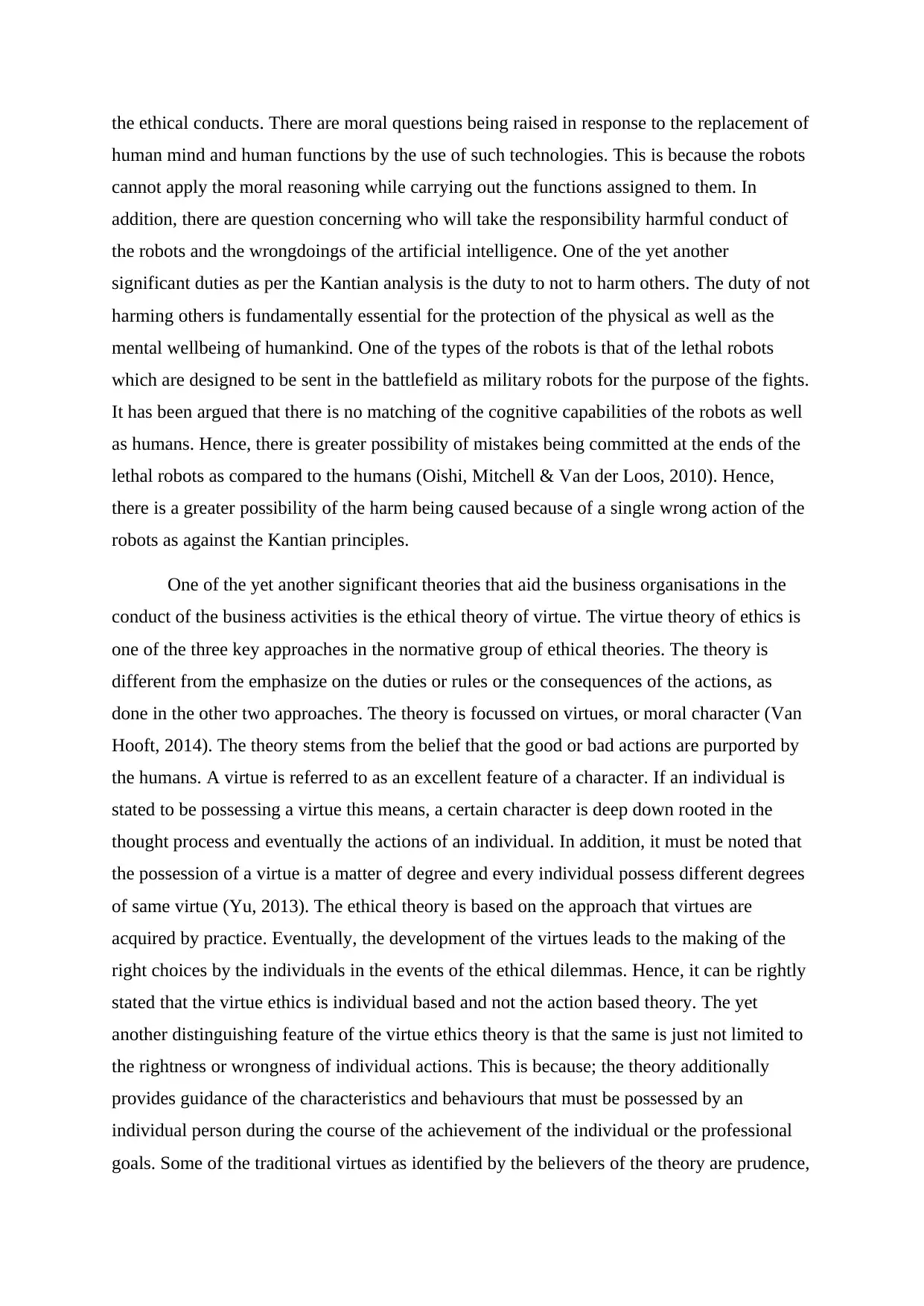
the ethical conducts. There are moral questions being raised in response to the replacement of
human mind and human functions by the use of such technologies. This is because the robots
cannot apply the moral reasoning while carrying out the functions assigned to them. In
addition, there are question concerning who will take the responsibility harmful conduct of
the robots and the wrongdoings of the artificial intelligence. One of the yet another
significant duties as per the Kantian analysis is the duty to not to harm others. The duty of not
harming others is fundamentally essential for the protection of the physical as well as the
mental wellbeing of humankind. One of the types of the robots is that of the lethal robots
which are designed to be sent in the battlefield as military robots for the purpose of the fights.
It has been argued that there is no matching of the cognitive capabilities of the robots as well
as humans. Hence, there is greater possibility of mistakes being committed at the ends of the
lethal robots as compared to the humans (Oishi, Mitchell & Van der Loos, 2010). Hence,
there is a greater possibility of the harm being caused because of a single wrong action of the
robots as against the Kantian principles.
One of the yet another significant theories that aid the business organisations in the
conduct of the business activities is the ethical theory of virtue. The virtue theory of ethics is
one of the three key approaches in the normative group of ethical theories. The theory is
different from the emphasize on the duties or rules or the consequences of the actions, as
done in the other two approaches. The theory is focussed on virtues, or moral character (Van
Hooft, 2014). The theory stems from the belief that the good or bad actions are purported by
the humans. A virtue is referred to as an excellent feature of a character. If an individual is
stated to be possessing a virtue this means, a certain character is deep down rooted in the
thought process and eventually the actions of an individual. In addition, it must be noted that
the possession of a virtue is a matter of degree and every individual possess different degrees
of same virtue (Yu, 2013). The ethical theory is based on the approach that virtues are
acquired by practice. Eventually, the development of the virtues leads to the making of the
right choices by the individuals in the events of the ethical dilemmas. Hence, it can be rightly
stated that the virtue ethics is individual based and not the action based theory. The yet
another distinguishing feature of the virtue ethics theory is that the same is just not limited to
the rightness or wrongness of individual actions. This is because; the theory additionally
provides guidance of the characteristics and behaviours that must be possessed by an
individual person during the course of the achievement of the individual or the professional
goals. Some of the traditional virtues as identified by the believers of the theory are prudence,
human mind and human functions by the use of such technologies. This is because the robots
cannot apply the moral reasoning while carrying out the functions assigned to them. In
addition, there are question concerning who will take the responsibility harmful conduct of
the robots and the wrongdoings of the artificial intelligence. One of the yet another
significant duties as per the Kantian analysis is the duty to not to harm others. The duty of not
harming others is fundamentally essential for the protection of the physical as well as the
mental wellbeing of humankind. One of the types of the robots is that of the lethal robots
which are designed to be sent in the battlefield as military robots for the purpose of the fights.
It has been argued that there is no matching of the cognitive capabilities of the robots as well
as humans. Hence, there is greater possibility of mistakes being committed at the ends of the
lethal robots as compared to the humans (Oishi, Mitchell & Van der Loos, 2010). Hence,
there is a greater possibility of the harm being caused because of a single wrong action of the
robots as against the Kantian principles.
One of the yet another significant theories that aid the business organisations in the
conduct of the business activities is the ethical theory of virtue. The virtue theory of ethics is
one of the three key approaches in the normative group of ethical theories. The theory is
different from the emphasize on the duties or rules or the consequences of the actions, as
done in the other two approaches. The theory is focussed on virtues, or moral character (Van
Hooft, 2014). The theory stems from the belief that the good or bad actions are purported by
the humans. A virtue is referred to as an excellent feature of a character. If an individual is
stated to be possessing a virtue this means, a certain character is deep down rooted in the
thought process and eventually the actions of an individual. In addition, it must be noted that
the possession of a virtue is a matter of degree and every individual possess different degrees
of same virtue (Yu, 2013). The ethical theory is based on the approach that virtues are
acquired by practice. Eventually, the development of the virtues leads to the making of the
right choices by the individuals in the events of the ethical dilemmas. Hence, it can be rightly
stated that the virtue ethics is individual based and not the action based theory. The yet
another distinguishing feature of the virtue ethics theory is that the same is just not limited to
the rightness or wrongness of individual actions. This is because; the theory additionally
provides guidance of the characteristics and behaviours that must be possessed by an
individual person during the course of the achievement of the individual or the professional
goals. Some of the traditional virtues as identified by the believers of the theory are prudence,
Paraphrase This Document
Need a fresh take? Get an instant paraphrase of this document with our AI Paraphraser
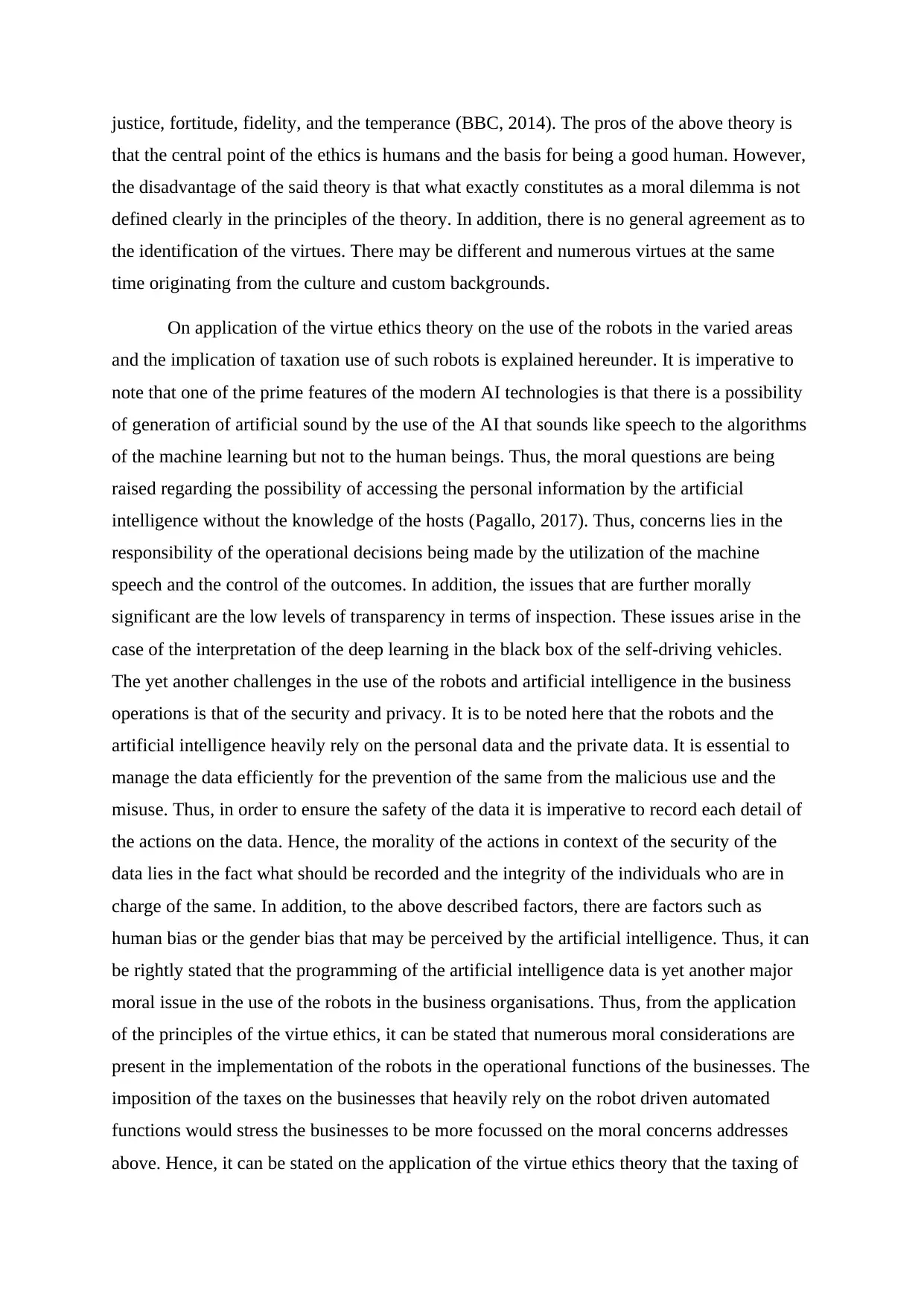
justice, fortitude, fidelity, and the temperance (BBC, 2014). The pros of the above theory is
that the central point of the ethics is humans and the basis for being a good human. However,
the disadvantage of the said theory is that what exactly constitutes as a moral dilemma is not
defined clearly in the principles of the theory. In addition, there is no general agreement as to
the identification of the virtues. There may be different and numerous virtues at the same
time originating from the culture and custom backgrounds.
On application of the virtue ethics theory on the use of the robots in the varied areas
and the implication of taxation use of such robots is explained hereunder. It is imperative to
note that one of the prime features of the modern AI technologies is that there is a possibility
of generation of artificial sound by the use of the AI that sounds like speech to the algorithms
of the machine learning but not to the human beings. Thus, the moral questions are being
raised regarding the possibility of accessing the personal information by the artificial
intelligence without the knowledge of the hosts (Pagallo, 2017). Thus, concerns lies in the
responsibility of the operational decisions being made by the utilization of the machine
speech and the control of the outcomes. In addition, the issues that are further morally
significant are the low levels of transparency in terms of inspection. These issues arise in the
case of the interpretation of the deep learning in the black box of the self-driving vehicles.
The yet another challenges in the use of the robots and artificial intelligence in the business
operations is that of the security and privacy. It is to be noted here that the robots and the
artificial intelligence heavily rely on the personal data and the private data. It is essential to
manage the data efficiently for the prevention of the same from the malicious use and the
misuse. Thus, in order to ensure the safety of the data it is imperative to record each detail of
the actions on the data. Hence, the morality of the actions in context of the security of the
data lies in the fact what should be recorded and the integrity of the individuals who are in
charge of the same. In addition, to the above described factors, there are factors such as
human bias or the gender bias that may be perceived by the artificial intelligence. Thus, it can
be rightly stated that the programming of the artificial intelligence data is yet another major
moral issue in the use of the robots in the business organisations. Thus, from the application
of the principles of the virtue ethics, it can be stated that numerous moral considerations are
present in the implementation of the robots in the operational functions of the businesses. The
imposition of the taxes on the businesses that heavily rely on the robot driven automated
functions would stress the businesses to be more focussed on the moral concerns addresses
above. Hence, it can be stated on the application of the virtue ethics theory that the taxing of
that the central point of the ethics is humans and the basis for being a good human. However,
the disadvantage of the said theory is that what exactly constitutes as a moral dilemma is not
defined clearly in the principles of the theory. In addition, there is no general agreement as to
the identification of the virtues. There may be different and numerous virtues at the same
time originating from the culture and custom backgrounds.
On application of the virtue ethics theory on the use of the robots in the varied areas
and the implication of taxation use of such robots is explained hereunder. It is imperative to
note that one of the prime features of the modern AI technologies is that there is a possibility
of generation of artificial sound by the use of the AI that sounds like speech to the algorithms
of the machine learning but not to the human beings. Thus, the moral questions are being
raised regarding the possibility of accessing the personal information by the artificial
intelligence without the knowledge of the hosts (Pagallo, 2017). Thus, concerns lies in the
responsibility of the operational decisions being made by the utilization of the machine
speech and the control of the outcomes. In addition, the issues that are further morally
significant are the low levels of transparency in terms of inspection. These issues arise in the
case of the interpretation of the deep learning in the black box of the self-driving vehicles.
The yet another challenges in the use of the robots and artificial intelligence in the business
operations is that of the security and privacy. It is to be noted here that the robots and the
artificial intelligence heavily rely on the personal data and the private data. It is essential to
manage the data efficiently for the prevention of the same from the malicious use and the
misuse. Thus, in order to ensure the safety of the data it is imperative to record each detail of
the actions on the data. Hence, the morality of the actions in context of the security of the
data lies in the fact what should be recorded and the integrity of the individuals who are in
charge of the same. In addition, to the above described factors, there are factors such as
human bias or the gender bias that may be perceived by the artificial intelligence. Thus, it can
be rightly stated that the programming of the artificial intelligence data is yet another major
moral issue in the use of the robots in the business organisations. Thus, from the application
of the principles of the virtue ethics, it can be stated that numerous moral considerations are
present in the implementation of the robots in the operational functions of the businesses. The
imposition of the taxes on the businesses that heavily rely on the robot driven automated
functions would stress the businesses to be more focussed on the moral concerns addresses
above. Hence, it can be stated on the application of the virtue ethics theory that the taxing of
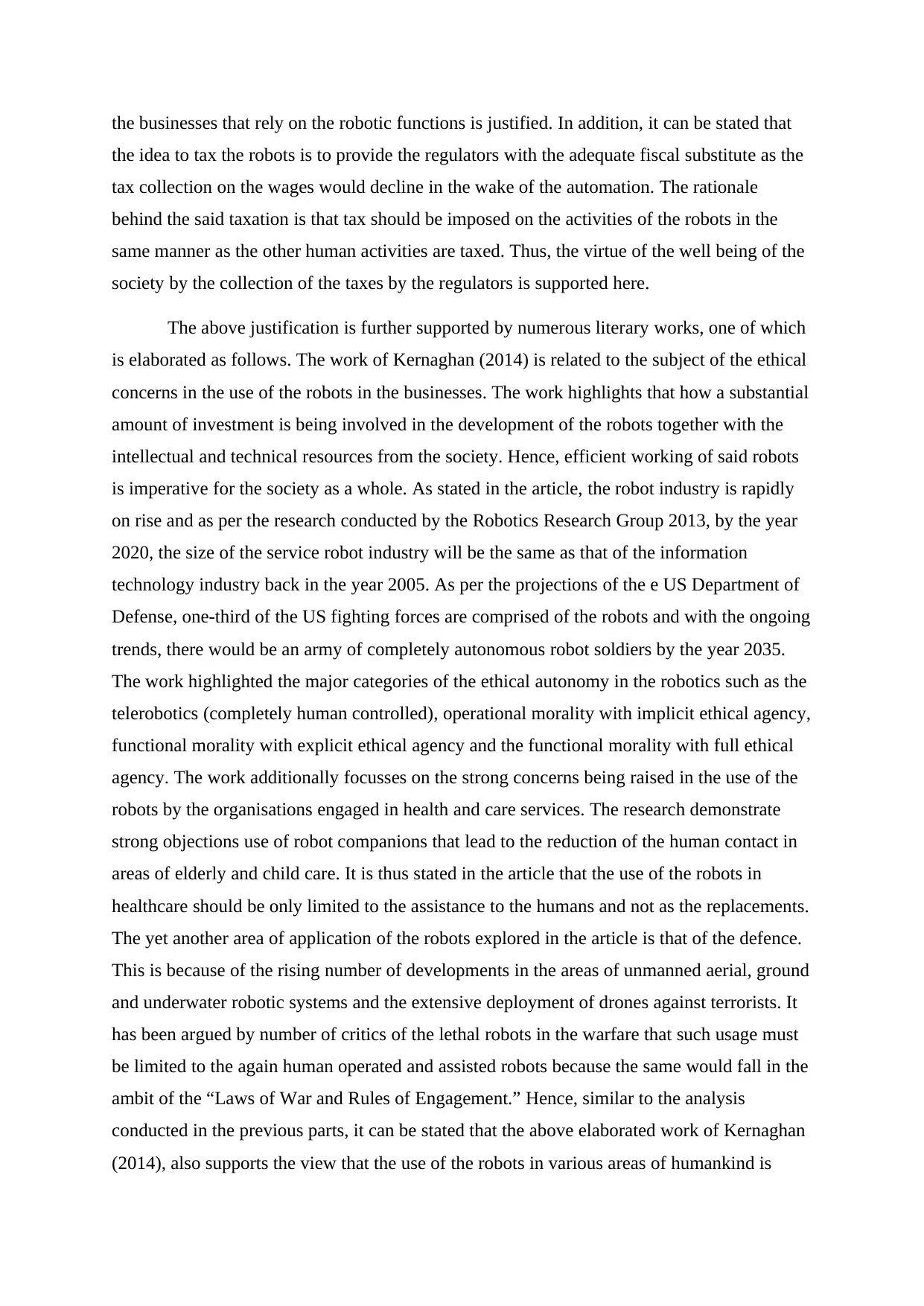
the businesses that rely on the robotic functions is justified. In addition, it can be stated that
the idea to tax the robots is to provide the regulators with the adequate fiscal substitute as the
tax collection on the wages would decline in the wake of the automation. The rationale
behind the said taxation is that tax should be imposed on the activities of the robots in the
same manner as the other human activities are taxed. Thus, the virtue of the well being of the
society by the collection of the taxes by the regulators is supported here.
The above justification is further supported by numerous literary works, one of which
is elaborated as follows. The work of Kernaghan (2014) is related to the subject of the ethical
concerns in the use of the robots in the businesses. The work highlights that how a substantial
amount of investment is being involved in the development of the robots together with the
intellectual and technical resources from the society. Hence, efficient working of said robots
is imperative for the society as a whole. As stated in the article, the robot industry is rapidly
on rise and as per the research conducted by the Robotics Research Group 2013, by the year
2020, the size of the service robot industry will be the same as that of the information
technology industry back in the year 2005. As per the projections of the e US Department of
Defense, one-third of the US fighting forces are comprised of the robots and with the ongoing
trends, there would be an army of completely autonomous robot soldiers by the year 2035.
The work highlighted the major categories of the ethical autonomy in the robotics such as the
telerobotics (completely human controlled), operational morality with implicit ethical agency,
functional morality with explicit ethical agency and the functional morality with full ethical
agency. The work additionally focusses on the strong concerns being raised in the use of the
robots by the organisations engaged in health and care services. The research demonstrate
strong objections use of robot companions that lead to the reduction of the human contact in
areas of elderly and child care. It is thus stated in the article that the use of the robots in
healthcare should be only limited to the assistance to the humans and not as the replacements.
The yet another area of application of the robots explored in the article is that of the defence.
This is because of the rising number of developments in the areas of unmanned aerial, ground
and underwater robotic systems and the extensive deployment of drones against terrorists. It
has been argued by number of critics of the lethal robots in the warfare that such usage must
be limited to the again human operated and assisted robots because the same would fall in the
ambit of the “Laws of War and Rules of Engagement.” Hence, similar to the analysis
conducted in the previous parts, it can be stated that the above elaborated work of Kernaghan
(2014), also supports the view that the use of the robots in various areas of humankind is
the idea to tax the robots is to provide the regulators with the adequate fiscal substitute as the
tax collection on the wages would decline in the wake of the automation. The rationale
behind the said taxation is that tax should be imposed on the activities of the robots in the
same manner as the other human activities are taxed. Thus, the virtue of the well being of the
society by the collection of the taxes by the regulators is supported here.
The above justification is further supported by numerous literary works, one of which
is elaborated as follows. The work of Kernaghan (2014) is related to the subject of the ethical
concerns in the use of the robots in the businesses. The work highlights that how a substantial
amount of investment is being involved in the development of the robots together with the
intellectual and technical resources from the society. Hence, efficient working of said robots
is imperative for the society as a whole. As stated in the article, the robot industry is rapidly
on rise and as per the research conducted by the Robotics Research Group 2013, by the year
2020, the size of the service robot industry will be the same as that of the information
technology industry back in the year 2005. As per the projections of the e US Department of
Defense, one-third of the US fighting forces are comprised of the robots and with the ongoing
trends, there would be an army of completely autonomous robot soldiers by the year 2035.
The work highlighted the major categories of the ethical autonomy in the robotics such as the
telerobotics (completely human controlled), operational morality with implicit ethical agency,
functional morality with explicit ethical agency and the functional morality with full ethical
agency. The work additionally focusses on the strong concerns being raised in the use of the
robots by the organisations engaged in health and care services. The research demonstrate
strong objections use of robot companions that lead to the reduction of the human contact in
areas of elderly and child care. It is thus stated in the article that the use of the robots in
healthcare should be only limited to the assistance to the humans and not as the replacements.
The yet another area of application of the robots explored in the article is that of the defence.
This is because of the rising number of developments in the areas of unmanned aerial, ground
and underwater robotic systems and the extensive deployment of drones against terrorists. It
has been argued by number of critics of the lethal robots in the warfare that such usage must
be limited to the again human operated and assisted robots because the same would fall in the
ambit of the “Laws of War and Rules of Engagement.” Hence, similar to the analysis
conducted in the previous parts, it can be stated that the above elaborated work of Kernaghan
(2014), also supports the view that the use of the robots in various areas of humankind is
⊘ This is a preview!⊘
Do you want full access?
Subscribe today to unlock all pages.

Trusted by 1+ million students worldwide
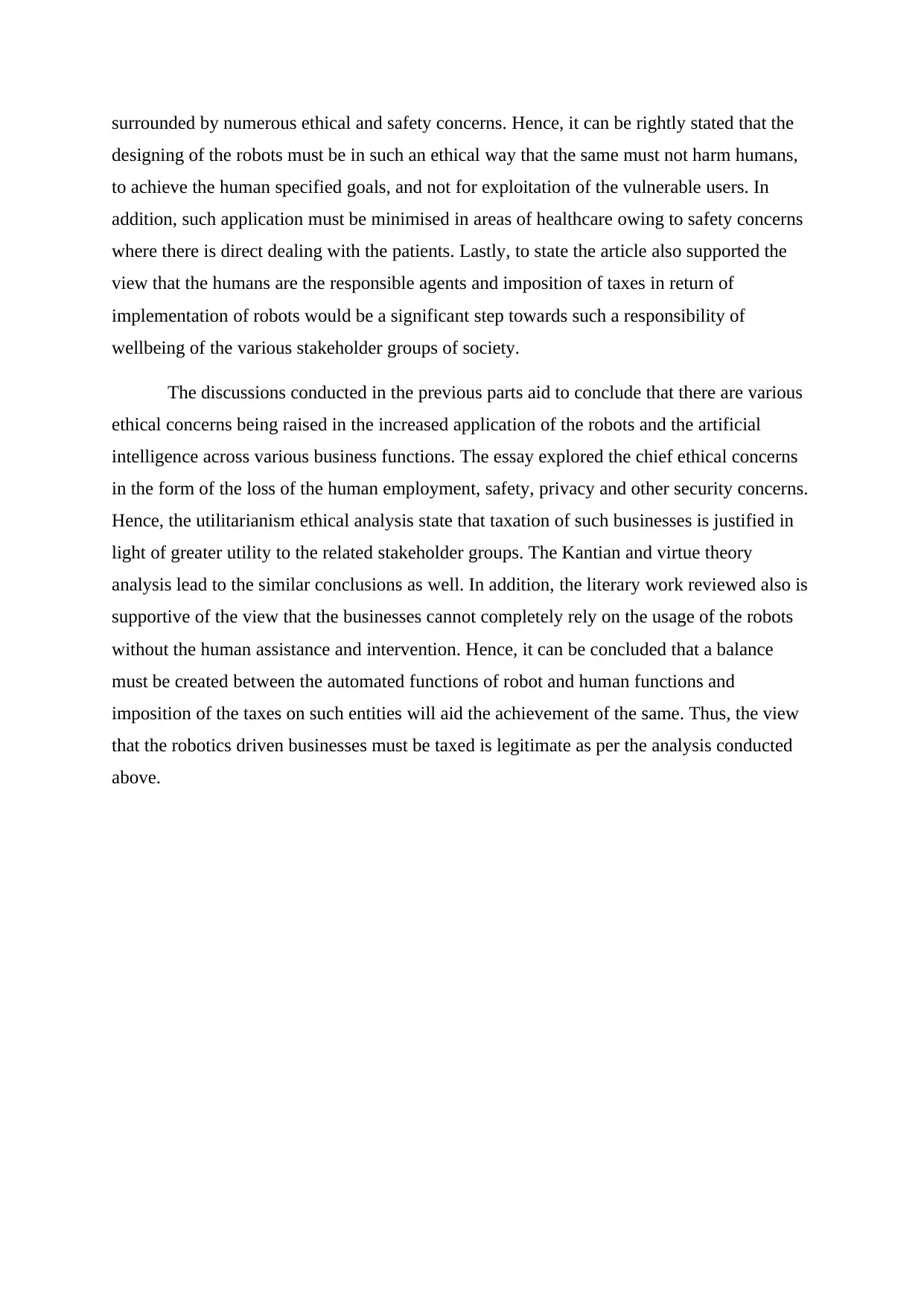
surrounded by numerous ethical and safety concerns. Hence, it can be rightly stated that the
designing of the robots must be in such an ethical way that the same must not harm humans,
to achieve the human specified goals, and not for exploitation of the vulnerable users. In
addition, such application must be minimised in areas of healthcare owing to safety concerns
where there is direct dealing with the patients. Lastly, to state the article also supported the
view that the humans are the responsible agents and imposition of taxes in return of
implementation of robots would be a significant step towards such a responsibility of
wellbeing of the various stakeholder groups of society.
The discussions conducted in the previous parts aid to conclude that there are various
ethical concerns being raised in the increased application of the robots and the artificial
intelligence across various business functions. The essay explored the chief ethical concerns
in the form of the loss of the human employment, safety, privacy and other security concerns.
Hence, the utilitarianism ethical analysis state that taxation of such businesses is justified in
light of greater utility to the related stakeholder groups. The Kantian and virtue theory
analysis lead to the similar conclusions as well. In addition, the literary work reviewed also is
supportive of the view that the businesses cannot completely rely on the usage of the robots
without the human assistance and intervention. Hence, it can be concluded that a balance
must be created between the automated functions of robot and human functions and
imposition of the taxes on such entities will aid the achievement of the same. Thus, the view
that the robotics driven businesses must be taxed is legitimate as per the analysis conducted
above.
designing of the robots must be in such an ethical way that the same must not harm humans,
to achieve the human specified goals, and not for exploitation of the vulnerable users. In
addition, such application must be minimised in areas of healthcare owing to safety concerns
where there is direct dealing with the patients. Lastly, to state the article also supported the
view that the humans are the responsible agents and imposition of taxes in return of
implementation of robots would be a significant step towards such a responsibility of
wellbeing of the various stakeholder groups of society.
The discussions conducted in the previous parts aid to conclude that there are various
ethical concerns being raised in the increased application of the robots and the artificial
intelligence across various business functions. The essay explored the chief ethical concerns
in the form of the loss of the human employment, safety, privacy and other security concerns.
Hence, the utilitarianism ethical analysis state that taxation of such businesses is justified in
light of greater utility to the related stakeholder groups. The Kantian and virtue theory
analysis lead to the similar conclusions as well. In addition, the literary work reviewed also is
supportive of the view that the businesses cannot completely rely on the usage of the robots
without the human assistance and intervention. Hence, it can be concluded that a balance
must be created between the automated functions of robot and human functions and
imposition of the taxes on such entities will aid the achievement of the same. Thus, the view
that the robotics driven businesses must be taxed is legitimate as per the analysis conducted
above.
Paraphrase This Document
Need a fresh take? Get an instant paraphrase of this document with our AI Paraphraser
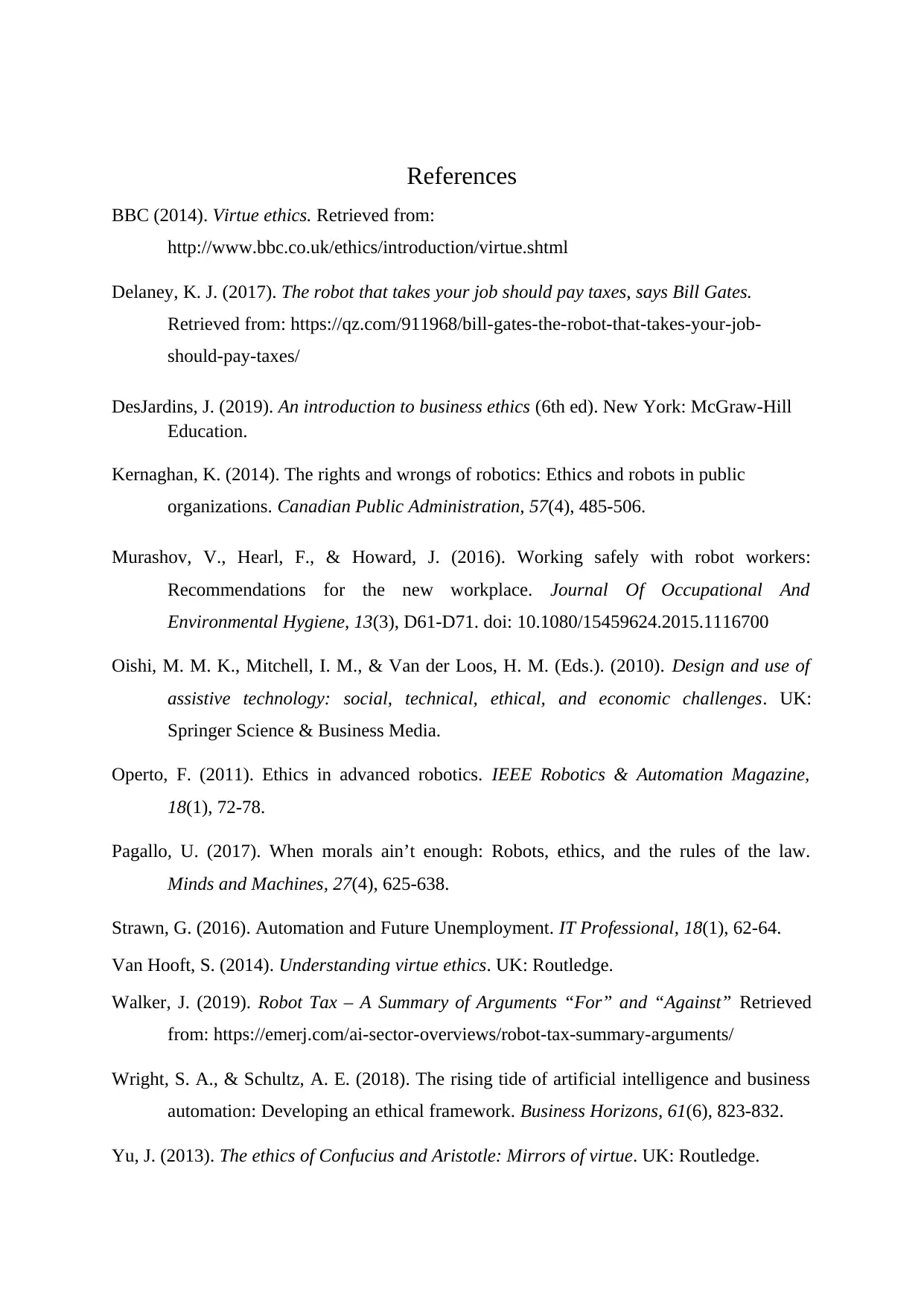
References
BBC (2014). Virtue ethics. Retrieved from:
http://www.bbc.co.uk/ethics/introduction/virtue.shtml
Delaney, K. J. (2017). The robot that takes your job should pay taxes, says Bill Gates.
Retrieved from: https://qz.com/911968/bill-gates-the-robot-that-takes-your-job-
should-pay-taxes/
DesJardins, J. (2019). An introduction to business ethics (6th ed). New York: McGraw-Hill
Education.
Kernaghan, K. (2014). The rights and wrongs of robotics: Ethics and robots in public
organizations. Canadian Public Administration, 57(4), 485-506.
Murashov, V., Hearl, F., & Howard, J. (2016). Working safely with robot workers:
Recommendations for the new workplace. Journal Of Occupational And
Environmental Hygiene, 13(3), D61-D71. doi: 10.1080/15459624.2015.1116700
Oishi, M. M. K., Mitchell, I. M., & Van der Loos, H. M. (Eds.). (2010). Design and use of
assistive technology: social, technical, ethical, and economic challenges. UK:
Springer Science & Business Media.
Operto, F. (2011). Ethics in advanced robotics. IEEE Robotics & Automation Magazine,
18(1), 72-78.
Pagallo, U. (2017). When morals ain’t enough: Robots, ethics, and the rules of the law.
Minds and Machines, 27(4), 625-638.
Strawn, G. (2016). Automation and Future Unemployment. IT Professional, 18(1), 62-64.
Van Hooft, S. (2014). Understanding virtue ethics. UK: Routledge.
Walker, J. (2019). Robot Tax – A Summary of Arguments “For” and “Against” Retrieved
from: https://emerj.com/ai-sector-overviews/robot-tax-summary-arguments/
Wright, S. A., & Schultz, A. E. (2018). The rising tide of artificial intelligence and business
automation: Developing an ethical framework. Business Horizons, 61(6), 823-832.
Yu, J. (2013). The ethics of Confucius and Aristotle: Mirrors of virtue. UK: Routledge.
BBC (2014). Virtue ethics. Retrieved from:
http://www.bbc.co.uk/ethics/introduction/virtue.shtml
Delaney, K. J. (2017). The robot that takes your job should pay taxes, says Bill Gates.
Retrieved from: https://qz.com/911968/bill-gates-the-robot-that-takes-your-job-
should-pay-taxes/
DesJardins, J. (2019). An introduction to business ethics (6th ed). New York: McGraw-Hill
Education.
Kernaghan, K. (2014). The rights and wrongs of robotics: Ethics and robots in public
organizations. Canadian Public Administration, 57(4), 485-506.
Murashov, V., Hearl, F., & Howard, J. (2016). Working safely with robot workers:
Recommendations for the new workplace. Journal Of Occupational And
Environmental Hygiene, 13(3), D61-D71. doi: 10.1080/15459624.2015.1116700
Oishi, M. M. K., Mitchell, I. M., & Van der Loos, H. M. (Eds.). (2010). Design and use of
assistive technology: social, technical, ethical, and economic challenges. UK:
Springer Science & Business Media.
Operto, F. (2011). Ethics in advanced robotics. IEEE Robotics & Automation Magazine,
18(1), 72-78.
Pagallo, U. (2017). When morals ain’t enough: Robots, ethics, and the rules of the law.
Minds and Machines, 27(4), 625-638.
Strawn, G. (2016). Automation and Future Unemployment. IT Professional, 18(1), 62-64.
Van Hooft, S. (2014). Understanding virtue ethics. UK: Routledge.
Walker, J. (2019). Robot Tax – A Summary of Arguments “For” and “Against” Retrieved
from: https://emerj.com/ai-sector-overviews/robot-tax-summary-arguments/
Wright, S. A., & Schultz, A. E. (2018). The rising tide of artificial intelligence and business
automation: Developing an ethical framework. Business Horizons, 61(6), 823-832.
Yu, J. (2013). The ethics of Confucius and Aristotle: Mirrors of virtue. UK: Routledge.
1 out of 8
Related Documents
Your All-in-One AI-Powered Toolkit for Academic Success.
+13062052269
info@desklib.com
Available 24*7 on WhatsApp / Email
![[object Object]](/_next/static/media/star-bottom.7253800d.svg)
Unlock your academic potential
Copyright © 2020–2025 A2Z Services. All Rights Reserved. Developed and managed by ZUCOL.




